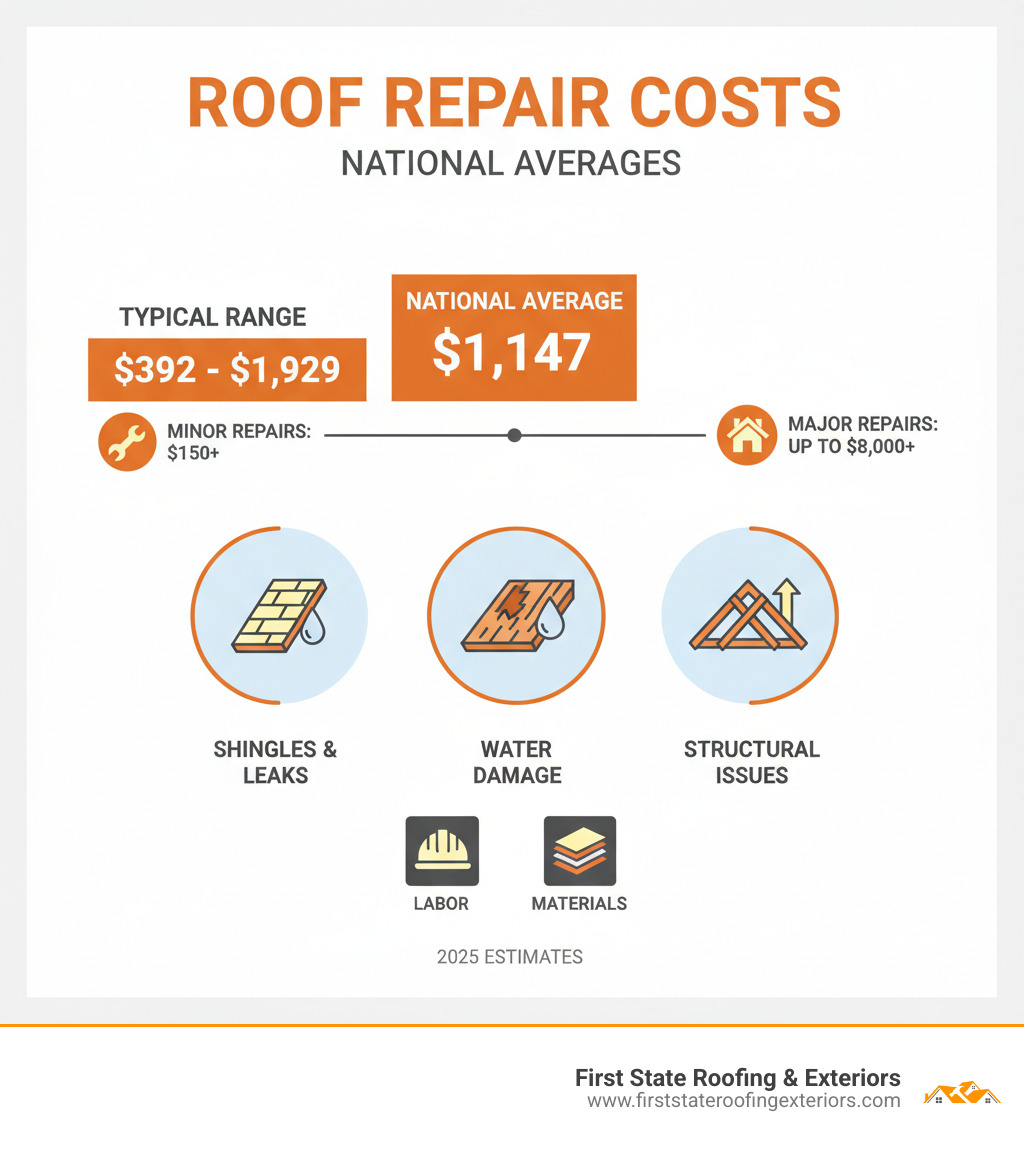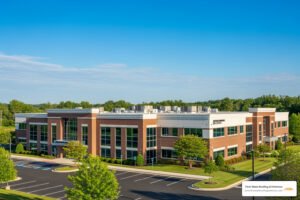Why Understanding Roof Repair Costs Matters for Delaware Homeowners
Roof repair prices typically range from $392 to $1,929 across the United States, with the national average sitting at $1,147. For those of us in the First State, these numbers are a starting point, but local factors can cause them to shift. Facing an unexpected roof issue is stressful enough without the added anxiety of uncertain costs, which is why understanding what goes into an estimate is essential for protecting your Delaware home. Delaware’s unique coastal climate, with its humid summers, risk of nor’easters, and occasional heavy snow, puts unique stress on our roofs. From high winds tearing off shingles near Bethany Beach to ice dams forming in Dover, the potential for damage is a year-round concern.
Here’s a quick look at what you can generally expect based on the severity of the issue:
- Minor repairs (small leaks, replacing a few shingles): $150–$1,000
- Moderate repairs (water damage, flashing replacement): $1,001–$2,500
- Major repairs (structural issues, sagging roof): $2,501–$8,000+
Many Delaware homeowners I speak with worry about being overcharged or pushed into a full replacement when a simple repair would suffice. The truth is, knowledge is your best defense. Understanding the typical cost ranges for different types of damage helps you budget effectively, ask the right questions, and spot an inflated quote from a mile away. This guide breaks down everything you need to know about roofing services pricing in Delaware—from material costs and labor rates to when repair makes sense versus full replacement.
What a Delaware roof repair estimate should include
To compare bids fairly and avoid surprises, insist on an itemized, written estimate that includes:
- Scope of work with the exact roof sections to be addressed and how they will be tied into existing materials.
- Line-item materials with quantities (shingle brand and series, underlayment type, flashing metals, fasteners, sealants, ventilation components).
- Labor details (crew size, estimated hours, and any steep-slope or two-story surcharges).
- Tear-off, disposal, and site protection plan (including dumpster or haul-away fees and property protection measures).
- Decking allowance (number of sheets or square feet of sheathing included before change orders apply).
- Flashing and ventilation plan (chimneys, skylights, plumbing boots, ridge/soffit vent corrections if needed).
- Permits and inspection fees if required by your municipality.
- Warranty terms (manufacturer material warranty and contractor workmanship warranty, each stated in years and what is covered).
- Start date window, projected duration, weather contingencies, and change-order policy.
- Proof of Delaware license and active liability/worker’s comp insurance.
How to compare bids “apples to apples”
- Confirm the same material line and wind-rating are specified on each quote.
- Ask for photos of the suspected leak source and the proposed repair area.
- Verify that flashing, sealants, and ventilation corrections are included—not just shingles.
- Check that clean-up, magnet sweep, and disposal are part of the price.
- Ensure payment terms are reasonable; avoid large upfront deposits for small repairs.
Local conditions can influence scope and price. Coastal homes in Lewes, Rehoboth, and Bethany Beach often benefit from corrosion-resistant fasteners and upgraded flashing due to salt air and higher wind exposure. Historic or HOA-controlled neighborhoods in Milford, Dover, Smyrna, and Milton may require specific shingle profiles or color approvals, which can affect both lead time and cost. Multi-family or commercial-style townhomes in Seaford or Greenwood may require additional safety staging and access planning.
I’m Richard McCain, owner of First State Roofing & Exteriors, and in over 20 years of serving Delaware homeowners from Smyrna to Seaford, I’ve seen how confusing roof repair prices can be for property owners. My goal is to provide transparent, factual information so you can make confident, informed decisions for your property.
If you’re ready for an honest assessment from a local expert, call us at (302) 222-4065 for a free inspection and free estimate.

Understanding the Average Cost of a Roof Repair
When you’re facing a roof problem, the first question is always, “How much will this cost?” While the national average for roof repairs is $1,147, with a typical range of $392 to $1,929, these figures are just a baseline. Simple fixes like replacing a few wind-damaged shingles might only be $150, whereas major structural work can easily exceed $8,000.
Here in Delaware, roof repair prices generally align with these national trends, but local factors like labor rates in Sussex County versus Kent County, material availability after a major storm, and regional building codes can influence the final cost. What truly matters is getting an honest assessment from a professional who understands the local market. That’s the advantage of working with a dedicated local Delaware roofer; we know what’s fair and what’s required to protect homes in our community.

Minor vs. Moderate vs. Major Repair Costs
Not all roof repairs are created equal. Understanding where your problem falls on the repair spectrum helps you set realistic expectations for what you’ll pay.
Minor Repairs ($150–$1,000): These are quick, targeted fixes for problems caught early. Examples include replacing a handful of shingles that a nor’easter lifted, patching a small puncture from a fallen branch (less than 6 inches in diameter), or resealing the flashing around a plumbing vent that has begun to dry out. The key here is that the damage is isolated and hasn’t compromised the underlying roof deck or underlayment. These repairs are often completed in a few hours and prevent small issues from becoming expensive water damage problems.
Moderate Repairs ($1,001–$2,500): This category involves more complexity and materials. Perhaps a leak has gone unnoticed for a few months, causing a small section of the plywood decking to soften and require replacement along with the shingles above it. Other examples include replacing all the flashing around a chimney that is failing, or addressing a larger area of shingle damage (up to a 10×10 foot section). These jobs require more investigation to determine the full extent of the water intrusion and more labor to properly integrate the new materials with the existing roof.
Major Repairs ($2,501–$8,000+): Here we’re addressing significant, often structural, problems. This could involve repairing roof trusses that have been damaged by a fallen tree, or correcting a sagging roofline caused by waterlogged decking or improper framing. These repairs are substantial and may require a section of the roof to be completely rebuilt from the rafters up. When repair costs start to approach this level, it’s crucial to have a serious discussion about the roof’s age and overall condition. A full roof replacement might offer better long-term value and peace of mind than a very expensive, large-scale repair on an otherwise aging roof.
Signs Your Roof Needs Repair
Knowing when to call for help can save you thousands of dollars. Catching problems early means they stay in that minor repair category instead of escalating into major structural work.
Leaking Ceilings and Water Stains
This is the most urgent sign. A brown, circular stain on your ceiling or a drip during a rainstorm means water has already breached all your roof’s defenses. Don’t ignore it, even if it seems small. Water can travel along rafters and inside walls, causing hidden mold growth and structural rot far from the visible stain. A professional can trace the leak back to its source, which may not be directly above the stain.
Missing, Curling, or Cracked Shingles
Take a walk around your home after a windy day. Are there bare patches on your roof? These are direct entry points for water. Shingles that are curling at the edges are a sign of both age and heat damage; they are brittle and can easily be torn off by wind. Cracked or “crazed” shingles have lost their flexibility and are failing. Any of these conditions compromise your roof’s ability to shed water.
Granules Collecting in Your Gutters
Those sand-like particles you see in your gutters are the protective top layer of your asphalt shingles. These ceramic-coated granules shield the underlying asphalt from damaging UV rays, which cause it to dry out and become brittle. When you see a large accumulation of granules, it’s a definitive sign that your shingles are nearing the end of their effective lifespan and are rapidly deteriorating.
A Sagging Roof Deck
This is a structural emergency. If you look at your roofline from the street and notice a dip, sway, or curve where it should be straight, call a professional immediately. A sagging roof can indicate broken or damaged rafters, waterlogged and rotting decking, or that the structure can no longer support its own weight. This poses a serious safety risk and must be addressed without delay.
Damaged Flashing
Flashing is the thin metal material installed wherever your roof meets a vertical surface—around chimneys, skylights, vents, and along walls. It’s designed to direct water away from these vulnerable seams. If the flashing is rusted, cracked, or has pulled away from the roof, it creates a superhighway for water to get into your home. Flashing failures are one of the most common sources of roof leaks.
Moss or Algae Growth
While dark streaks (often blue-green algae) are primarily a cosmetic issue, thick patches of moss are more sinister. Moss acts like a sponge, trapping moisture against your shingles. This constant dampness can accelerate granule loss and deterioration. In freezing climates like Delaware’s winters, the trapped water can freeze and expand, lifting the edges of your shingles and making them vulnerable to wind.
If you’re seeing any of these warning signs, it’s time for a professional assessment. A thorough roof inspection can identify problems before they become expensive disasters. Call us at (302) 222-4065 for a free inspection and free estimate.




